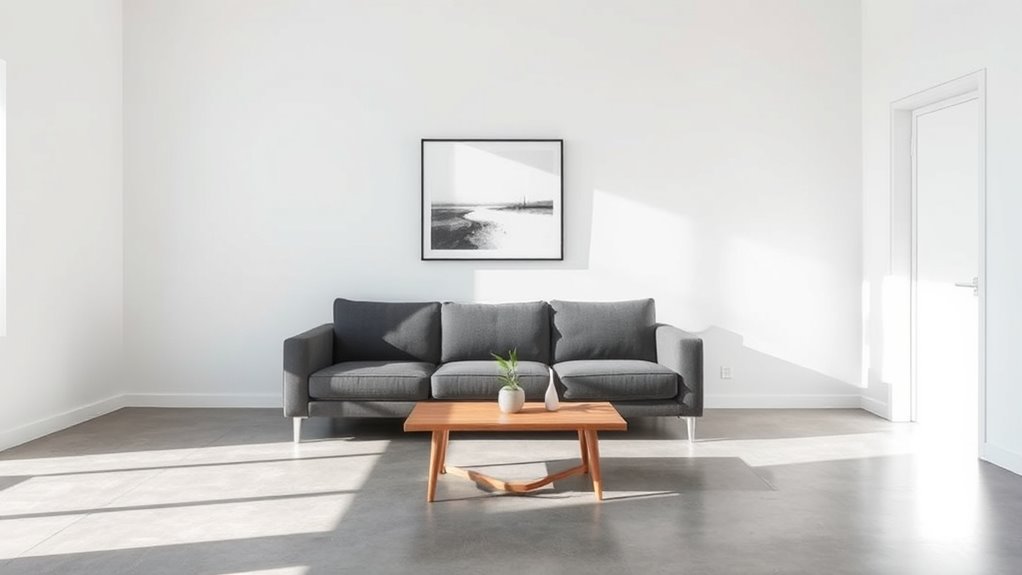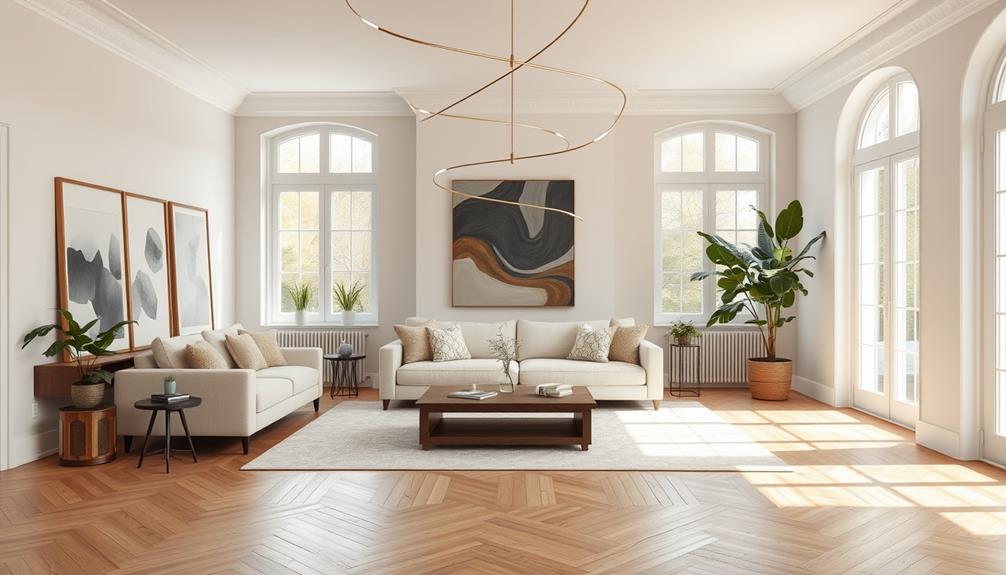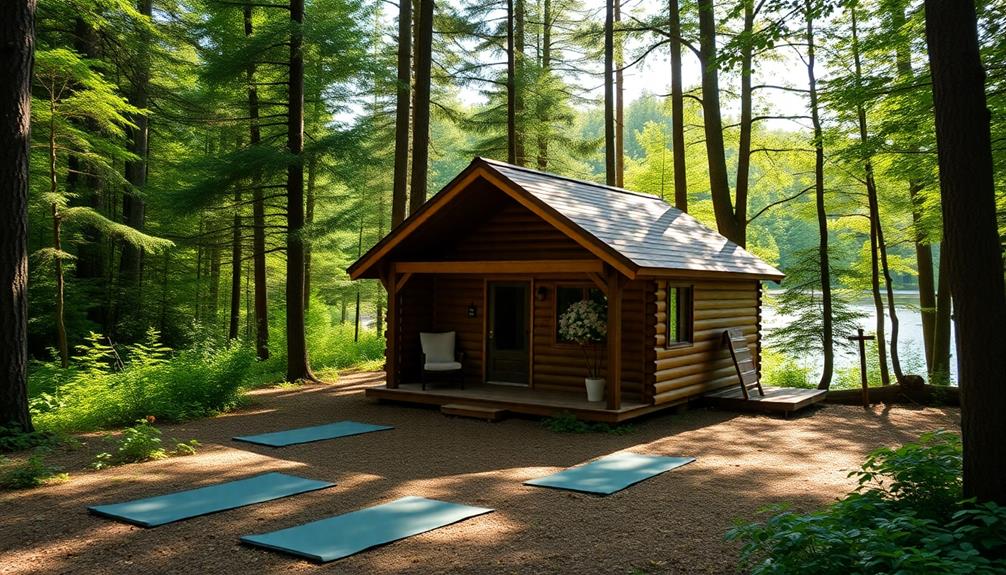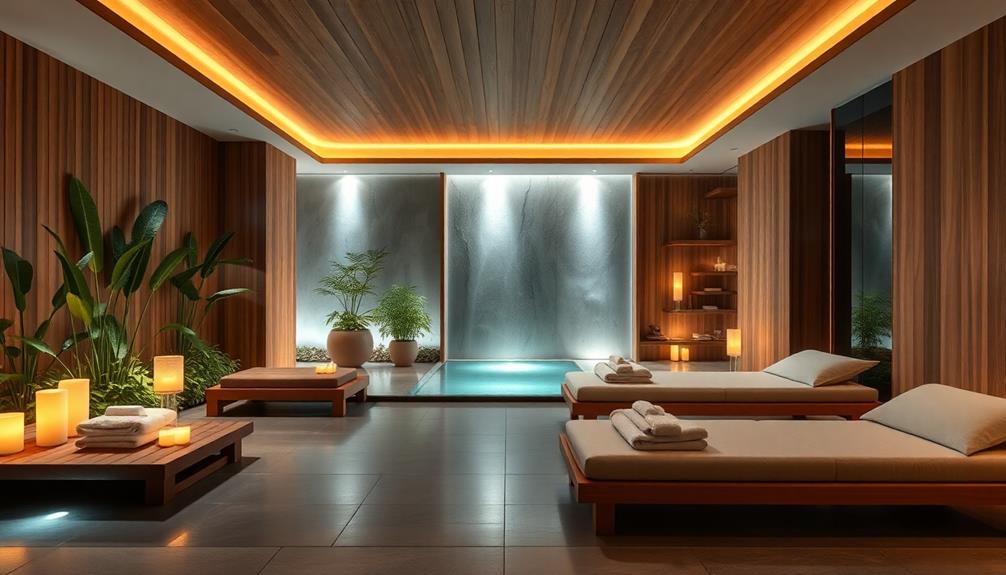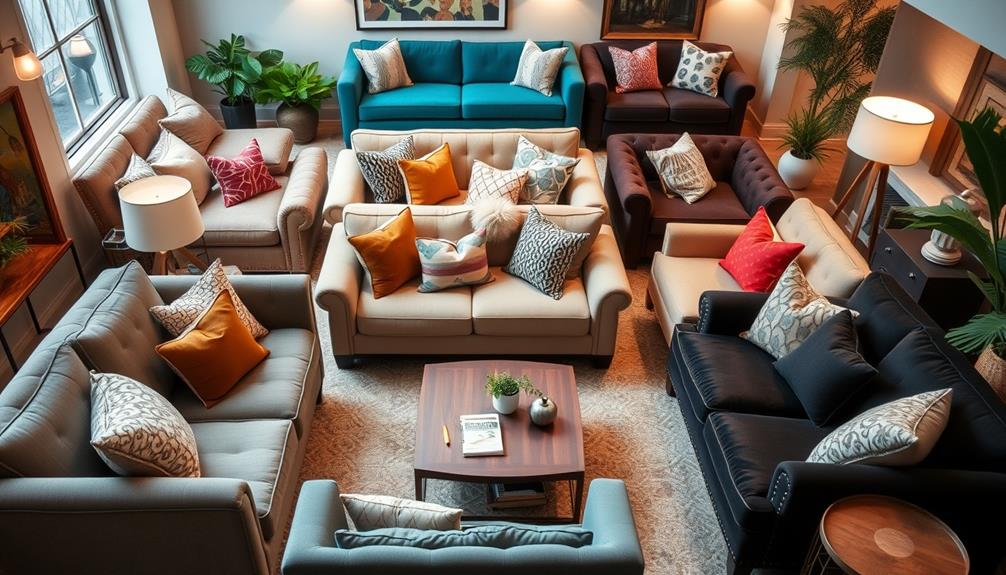The art of minimalist interior design revolves around creating calming, uncluttered spaces by focusing on simplicity and functionality. You choose neutral colors, clean lines, and versatile furniture that promotes openness. Prioritizing quality over quantity and maintaining organization helps sustain the minimalist vibe. Incorporating natural textures like wood and stone adds warmth without clutter. To achieve this effortlessly stylish environment, explore strategies that keep your space sleek and serene—more insights await.
Key Takeaways
- Focus on simplicity by emphasizing essential, functional furniture and open spaces to create a calm environment.
- Use neutral color palettes like beige, gray, and white to promote serenity and a sense of spaciousness.
- Incorporate natural materials such as wood and stone to add warmth and farmhouse charm.
- Prioritize organization with designated storage to maintain clutter-free, expansive living areas.
- Enhance textures with layered textiles and warm materials for depth while preserving minimalist elegance.
The Principles Behind Minimalist Design
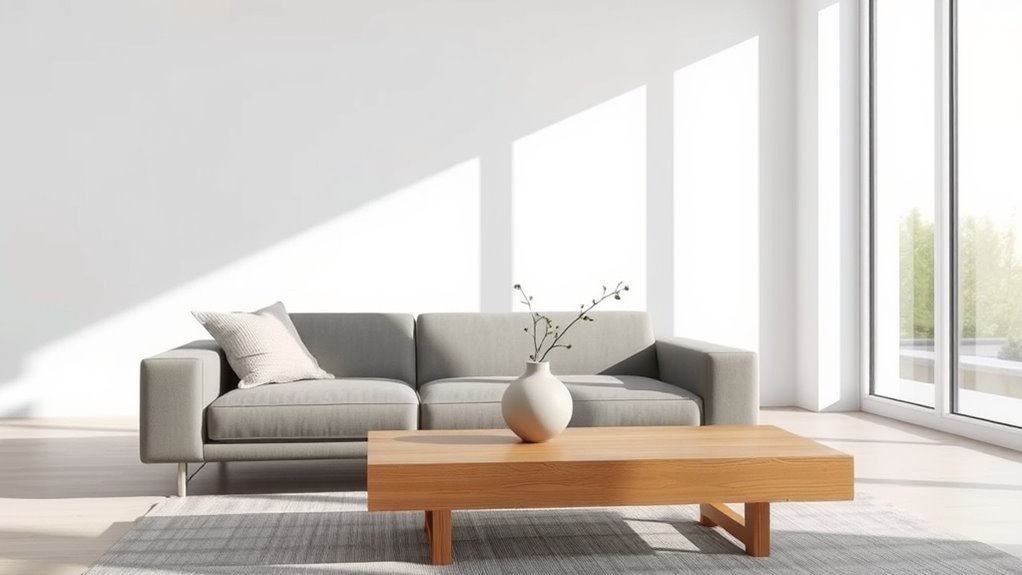
Minimalist interior design is rooted in the idea that less is more. You focus on simplicity, stripping away unnecessary clutter to highlight what’s essential. This approach emphasizes clean lines, functional furniture, and open spaces that create a sense of calm. You choose quality over quantity, investing in pieces that serve multiple purposes and stand out for their craftsmanship. Neutral colors often form the foundation, helping spaces feel airy and uncluttered, while strategic use of textures adds visual interest without overwhelming. You prioritize organization, making sure everything has a place, which enhances the minimalist aesthetic. Maintaining a clutter-free environment is crucial for sustaining the calming effect of minimalist design. The goal is to create a serene environment that promotes clarity and relaxation, allowing you to enjoy your space without distraction or chaos. Additionally, understanding the value of Worth – Kiss Me can inspire a sense of appreciation for well-crafted, timeless pieces that elevate minimalist spaces. Incorporating AI-powered tools can also streamline your design process, helping you visualize and implement minimalist concepts more efficiently. Employing dedicated storage solutions supports keeping surfaces clear and organized.
Choosing a Neutral Color Palette

Choosing a neutral color palette helps create a calming atmosphere in your space. Opt for versatile tones like soft beiges, warm grays, or crisp whites that complement any decor. These calming shades make it easy to update your look without overhauling your entire color scheme. Incorporating calming shades can also promote relaxation and mental clarity within your environment. Additionally, selecting colors with consistent lighting conditions ensures your space remains soothing throughout the day. Using self watering plant pots with neutral-colored containers can further enhance the minimalist aesthetic by maintaining a clean and cohesive look. Incorporating natural elements like wood accents or stone textures can deepen the sense of serenity and bring a touch of farmhouse charm to your decor. Exploring popular interior design trends can also provide fresh ideas for creating a serene and stylish environment.
Calming Shade Selections
Selecting the right neutral colors sets a calming tone for your space and creates a seamless backdrop for minimalist decor. Soft shades like warm beige, cool gray, or creamy whites evoke tranquility and make your room feel open and inviting. These calming hues help balance strong architectural details or statement furniture, ensuring nothing overwhelms the senses. When choosing shades, opt for muted tones that don’t distract but instead promote relaxation. Consider the natural lighting in your space, as it can alter how colors appear throughout the day. Subtle variations within your neutral palette add depth without clutter. Incorporating natural materials like wood or linen can further enhance the warmth and authenticity of the minimalist farmhouse style. The goal is to foster a serene environment where less is more, and your chosen shades support a peaceful, cohesive atmosphere.
Versatile Neutral Tones
A well-rounded neutral color palette provides the foundation for a versatile and cohesive minimalist interior. Choosing neutral tones like soft beiges, warm greys, and crisp whites creates a calm, sophisticated environment. These shades act as a blank canvas, allowing you to easily add accent pieces or textures without overwhelming the space. Neutral colors also enhance natural light, making rooms feel brighter and more open. When selecting your palette, consider variation in undertones to add depth and interest while maintaining simplicity. You can mix matte and glossy finishes to create subtle contrast. Remember, neutrals are timeless; they won’t go out of style and provide flexibility as your tastes evolve. Incorporating neutral color palettes can also help set a tranquil mood and promote relaxation in your space. Integrating high-quality paints ensures that your chosen tones remain vibrant and durable over time. With versatile neutral tones, you set the perfect stage for minimalist elegance that’s both functional and inviting.
Selecting Functional and Elegant Furniture
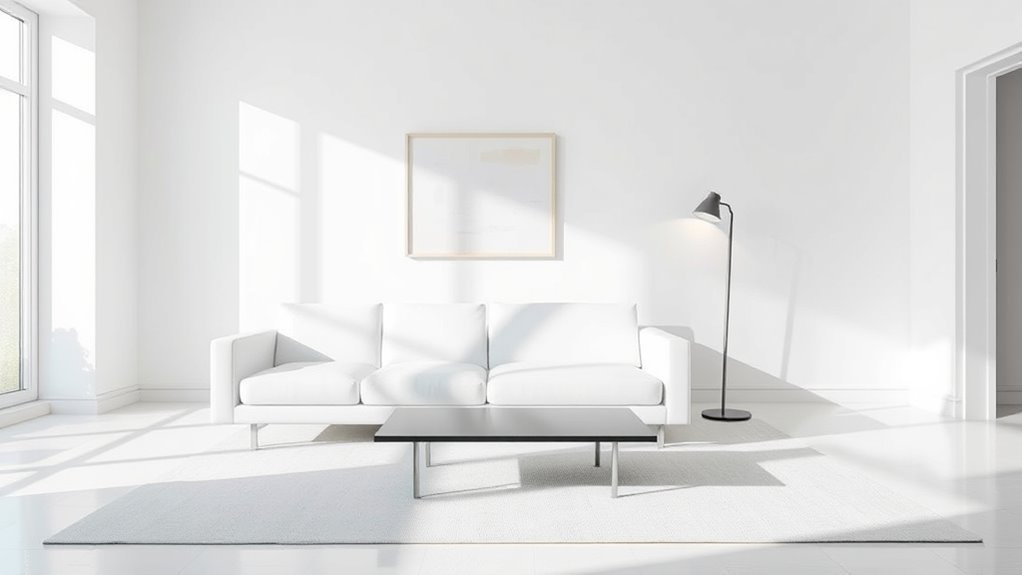
When aiming for a minimalist interior, prioritizing furniture that balances functionality with elegance is essential. Choose pieces that serve a clear purpose without unnecessary ornamentation. Opt for clean lines, simple shapes, and high-quality materials to create a sophisticated look. Multi-functional furniture, like a storage ottoman or fold-out desk, helps maximize space while maintaining style. Additionally, selecting versatile materials that complement the overall design enhances cohesion and durability. Incorporating layered textures and colors can also add warmth and depth to the minimal aesthetic without cluttering the space. Selecting furniture with innovative storage solutions can further optimize your space and maintain a clutter-free environment. Emphasizing customizable options allows you to tailor pieces to your specific needs and style preferences. Below is a guide to select versatile pieces:
| Functionality | Elegance |
|---|---|
| Compact, multi-use | Sleek, understated design |
| Hidden storage | Neutral tones and textures |
| Lightweight, movable | Timeless materials (wood, metal) |
Focus on quality over quantity, ensuring each piece complements your space and reflects your taste. This approach creates a clean, purposeful environment. Incorporating balanced designs ensures harmony and visual appeal in your minimalist space.
Creating a Sense of Space and Openness
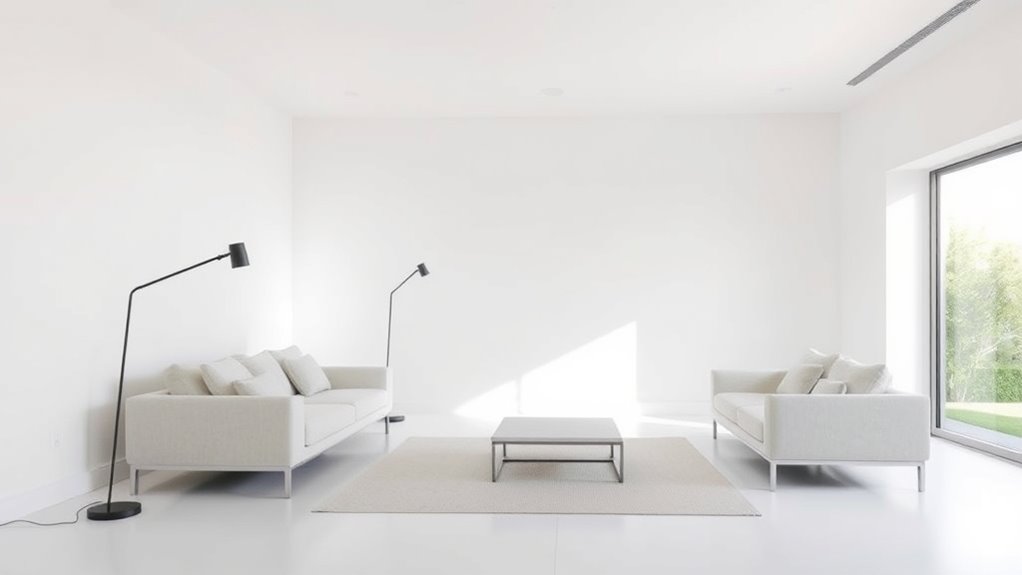
To create a sense of space and openness in your minimalist interior, focus on maximizing natural light and minimizing visual clutter. Keep windows unobstructed by using simple, unobtrusive window treatments like sheer curtains or blinds. Use a light color palette for walls, floors, and furniture to reflect light and make the space feel larger. Avoid overcrowding by choosing only essential furniture pieces and arranging them with plenty of open space around them. Incorporate open shelving instead of bulky storage units to reduce clutter. Keep surfaces clear and organized, using hidden storage where possible. The goal is to create a calm, airy environment that feels expansive and inviting, emphasizing simplicity and spaciousness through thoughtful design choices. Additionally, utilizing necessary cookies can ensure the website functions smoothly as you plan your ideal space. The use of contrast ratio in lighting and decor choices can further enhance the perception of depth and openness in your environment. Incorporating wall organization systems can also help maintain a clutter-free, streamlined look that complements minimalist design. Opting for vertical storage solutions can maximize space efficiency and keep surfaces clear, contributing to the overall sense of openness. Consider integrating elements of farmhouse decor, such as natural materials and vintage accessories, to add warmth and character without compromising the minimal aesthetic.
Incorporating Texture and Warmth
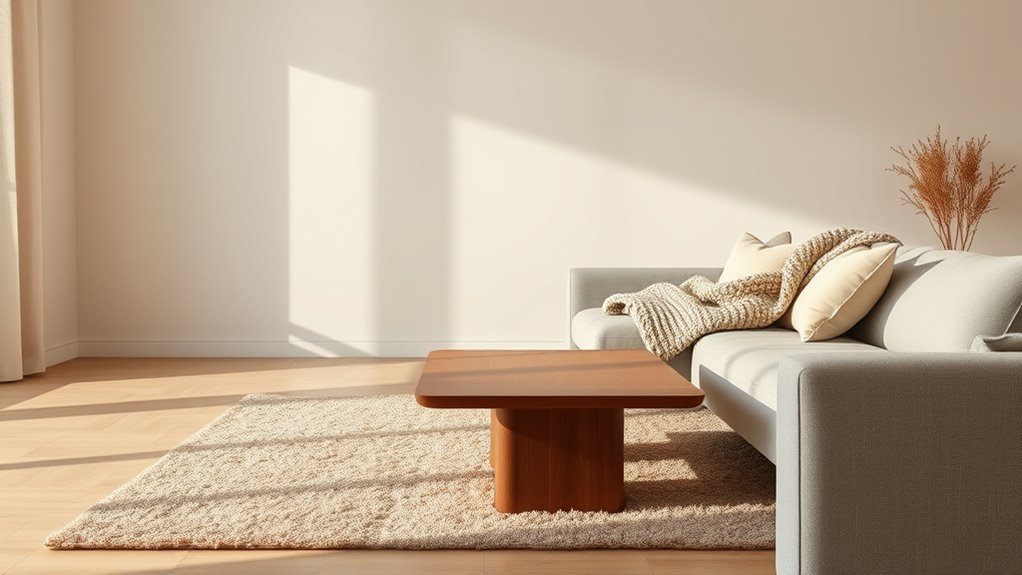
Adding layered textures like soft rugs or woven throws instantly adds depth to your space. Warm materials such as wood or plush fabrics create a cozy atmosphere without cluttering. These touches help balance minimalism with inviting comfort. Incorporating local tips can further enhance the ambiance by reflecting the unique character of your environment. Additionally, selecting diversified materials in your furnishings can contribute to a richer, more engaging aesthetic while maintaining simplicity. Embracing textural variety can also heighten visual interest and tactile appeal, elevating your minimalist design. Exploring mindset principles from the Law of Attraction can also help you create a space that feels both balanced and energetically aligned. Incorporating furniture with textured surfaces can further deepen the tactile experience within your minimalist aesthetic.
Layered Textures for Depth
Layering textures in a minimalist interior creates a sense of depth and invites tactile engagement. By mixing different materials, you add visual interest without clutter. Think about combining smooth surfaces with rough textiles or matte finishes with glossy accents. Incorporate varied textures through subtle details that complement your clean aesthetic. Utilizing cybersecurity measures in your design process can also protect your space from digital threats and ensure safety. Consider these options: – Soft wool or boucle throws on sleek furniture – Textured woven rugs to anchor the space – Matte and gloss ceramic or metal accessories – Linen or cotton curtains for a gentle touch – Leather or suede accent pieces for warmth These layers enhance the simplicity while adding richness and dimension. Keep the textures understated and balanced, so they enrich your space without overpowering the minimalist vibe.
Warm Materials for Coziness
In a minimalist interior, incorporating warm materials instantly makes the space feel more inviting and comfortable. Think plush wool rugs, soft leather furniture, or wooden accents that add richness without clutter. These textures bring depth and a tactile quality that balances the clean lines of minimalism. To enhance coziness, select materials that feel natural and soothing. Here’s a quick guide:
| Material | Effect |
|---|---|
| Wool | Soft, insulating, cozy |
| Leather | Durable, warm, sophisticated |
| Wood | Natural, grounding, inviting |
| Cork | Lightweight, tactile, warm |
| Linen | Light, breathable, soft |
Mixing these textures creates a layered, warm environment that invites relaxation without sacrificing simplicity.
Tips for Decluttering and Maintaining Simplicity
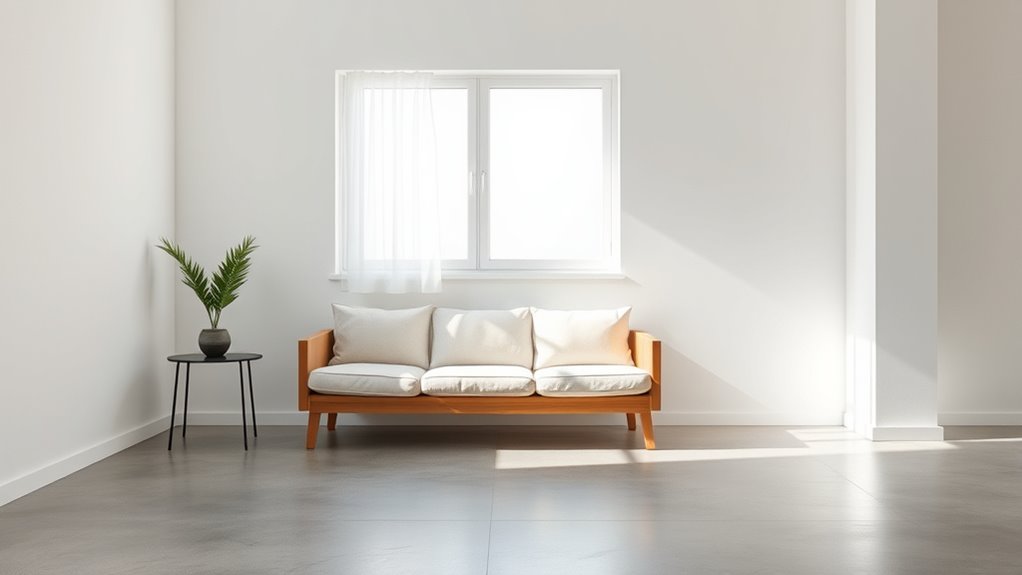
To effectively maintain a minimalist interior, you need to develop simple habits for decluttering and staying organized. Regularly evaluate your belongings and ask yourself if each item serves a purpose or brings you joy. Implement routines to keep clutter at bay, such as tidying daily and sorting items weekly. To stay on track, consider these tips:
- Set a specific day each week for decluttering
- Use storage solutions that hide away unnecessary items
- Limit new acquisitions by adopting a one-in, one-out rule
- Keep surfaces clear and free of unnecessary decorations
- Regularly review and donate items you no longer need
Inspiring Minimalist Interior Examples
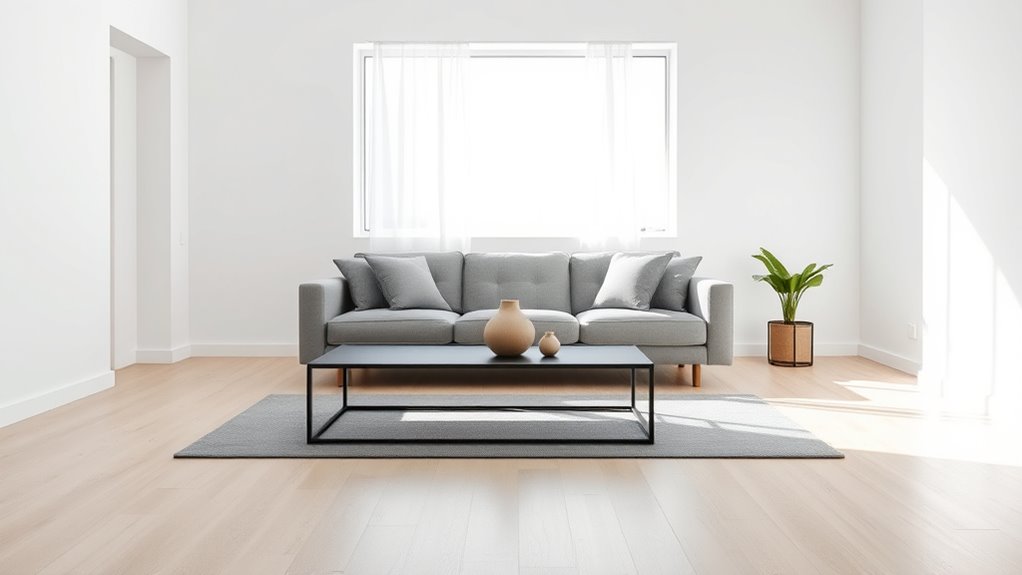
Minimalist interior designs showcase how simplicity and functionality can create stunning living spaces. You’ll notice that many inspiring examples emphasize clean lines, neutral palettes, and open layouts. For instance, a living room with a sleek sofa, a simple coffee table, and a few carefully chosen decor pieces can feel both inviting and uncluttered. In kitchens, you might see handle-less cabinets and hidden storage that keep surfaces clear. Bedrooms often feature a bed with a plain headboard and minimal bedding, promoting calmness. These examples prove that less truly is more, allowing natural light to highlight space and form. When you draw inspiration from these designs, you learn that thoughtfully curated details and restraint amplify your home’s serenity and style.
Frequently Asked Questions
How Can Minimalism Improve Mental Clarity and Reduce Stress?
Minimalism can boost your mental clarity and lower stress by creating a calm, clutter-free environment. When you simplify your space, you’re less distracted and more focused. It encourages organization, which makes it easier to find what you need and reduces anxiety. By stripping away excess, you foster a sense of peace and control, helping your mind relax and stay clear amidst daily chaos.
What Are Common Mistakes to Avoid in Minimalist Design?
You might think less is more, but avoiding common pitfalls is key. Don’t overdo the simplicity—cluttering with too many items defeats the purpose. Skip excessive ornamentation or mismatched furniture that disrupts harmony. Keep color schemes neutral and cohesive; avoid bold, chaotic hues. Remember, the goal is a calm space, so steer clear of overcrowding or neglecting functional elements. This way, your minimalist design stays true to its essence.
How Do I Personalize a Minimalist Space Without Clutter?
You can personalize a minimalist space by adding meaningful objects that reflect your personality, like a favorite artwork or a treasured photograph. Keep these items intentionally simple and avoid overcrowding surfaces. Use subtle colors or textures to create warmth without clutter. Incorporate personal touches in small ways, such as a unique vase or a cozy throw, ensuring each item enhances your space without overwhelming the clean, uncluttered aesthetic.
Can Minimalist Design Adapt to Small or Unconventional Spaces?
You can definitely make minimalist design work in small or unconventional spaces. Use multi-functional furniture to maximize limited areas, and choose sleek, simple pieces that don’t overwhelm the space. Keep walls and surfaces clear, adding just a few personal touches like a meaningful artwork or a unique rug. Focus on light colors and natural light to make the space feel bigger. With thoughtful planning, your small or quirky space will feel open and stylish.
What Are Eco-Friendly Materials Suited for Minimalist Interiors?
They say “less is more,” and that’s especially true for eco-friendly minimalist interiors. You can choose sustainable materials like bamboo, reclaimed wood, recycled metal, and organic cotton. These options reduce your environmental impact while maintaining clean, simple lines. Opt for low-VOC paints and natural fibers to enhance air quality. By selecting eco-friendly materials, you create a stylish, healthy space that aligns with your values and the minimalist ethos of simplicity.
Conclusion
Embracing minimalist interior design isn’t just about aesthetics; it can boost your well-being. Did you know that a clutter-free space can reduce stress by up to 20%? By simplifying your environment, you create a calm, functional oasis that feels both spacious and inviting. Keep it intentional and maintain your space regularly. Less truly is more—your home will become a peaceful retreat that energizes and inspires you every day.
